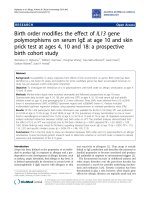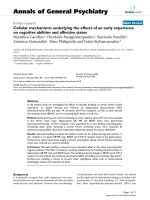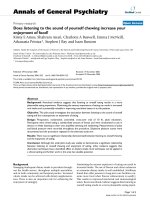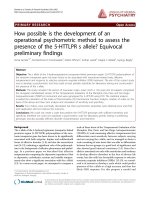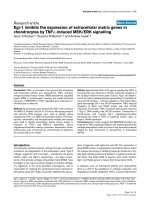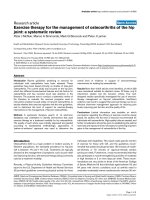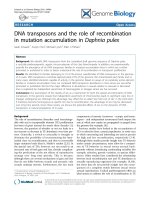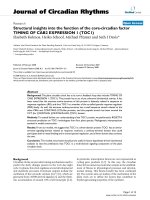Báo cáo y học: "Black Hawk Down: The evolution of resuscitation strategies in massive traumatic hemorrhage" doc
Bạn đang xem bản rút gọn của tài liệu. Xem và tải ngay bản đầy đủ của tài liệu tại đây (116.83 KB, 3 trang )
Available online at
Evidence-Based Medicine Journal Club
EBM Journal Club Section Editor: Eric B. Milbrandt, MD, MPH
Journal club critique
Black Hawk Down: The evolution of resuscitation strategies in
massive traumatic hemorrhage
Deepika Mohan
1
, Eric B. Milbrandt
2
, and Louis H. Alarcon
3
1
Clinical Fellow, Department of Critical Care Medicine, University of Pittsburgh School of Medicine, Pittsburgh, Pennsylvania, USA
2
Assistant Professor, Department of Critical Care Medicine, University of Pittsburgh School of Medicine, Pittsburgh, Pennsylvania, USA
3
Assistant Professor, Departments of Critical Care Medicine and Surgery, University of Pittsburgh School of Medicine, Pittsburgh, Pennsylvania, USA
Published online: 23
rd
July 2008
This article is online at
© 2008 BioMed Central Ltd
Critical Care 2008, 12:305 (DOI 10.1186/cc6946)
Expanded Abstract
Citation
Borgman MA, Spinella PC, Perkins JG, Grathwohl KW,
Repine T, Beekley AC, Sebesta J, Jenkins D, Wade CE,
Holcomb JB: The ratio of blood products transfused affects
mortality in patients receiving massive transfusions at a
combat support hospital. J Trauma 2007, 63:805-813 [1].
Background
Patients with severe traumatic injuries often present with
coagulopathy and require massive transfusion. The risk of
death from hemorrhagic shock increases in this population.
To treat the coagulopathy of trauma, some have suggested
early, aggressive correction using a 1:1 ratio of plasma to
red blood cell (RBC) units.
Methods
Objective: To determine whether the ratio of plasma to
RBCs transfused would affect survival by decreasing death
from hemorrhage.
Design: Retrospective chart review.
Setting: United States Army combat support hospital in
Iraq.
Subjects: 246 patients who received a massive transfusion
(≥10 units of RBCs in 24 hours) from November 2003 to
September 2005. Three groups of patients were constructed
according to the plasma to RBC ratio transfused during
massive transfusion.
Intervention: None.
Outcome: Hospital mortality rates and the cause of death
were compared among groups. Multivariable logistic
regression was used to determine the independent
association between plasma to RBC ratio and hospital
mortality.
Results
For the low ratio group the plasma to RBC median ratio was
1:8 (interquartile range (IQR), 0:12-1:5), for the medium
ratio group, 1:2.5 (IQR, 1:3.0-1:2.3), and for the high ratio
group, 1:1.4 (IQR, 1:1.7-1:1.2) (p<0.001). Median Injury
Severity Score (ISS) was 18 for all groups (IQR, 14-25). For
low, medium, and high plasma to RBC ratios, overall
mortality rates were 65%, 34%, and 19%, (p<0.001); and
hemorrhage mortality rates were 92.5%, 78%, and 37%,
respectively (p < 0.001). Upon logistic regression, plasma to
RBC ratio was independently associated with survival (odds
ratio 8.6, 95% confidence interval 2.1-35.2).
Conclusions
In patients with combat-related trauma requiring massive
transfusion, a high 1:1.4 plasma to RBC ratio is
independently associated with improved survival to hospital
discharge, primarily by decreasing death from hemorrhage.
For practical purposes, massive transfusion protocols
should utilize a 1:1 ratio of plasma to RBCs for all patients
who are hypocoagulable with traumatic injuries.
Commentary
On 3 October 1993, two hundred American soldiers caught
during a daytime raid participated in a firefight in the streets
of Mogadishu, Somalia. In the hours before extraction,
fourteen men died of their wounds in the field; more
succumbed first at the combat hospital and later in
Germany. That single event prompted a review by military
Page 1 of 3
(page number not for citation purposes)
Critical Care 2008, 12:305 Mohan, Milbrandt, and Alarcon
medical personnel of existing resuscitation practices,
rekindling debates begun at the time of World War I [2]. As
difficult as it is to imagine today, during World War I there
was commonly no preoperative resuscitation in combat
trauma. By World War II, resuscitation with colloid and blood
had become the standard approach. Only during Vietnam
did the work of Moyer, Shires, Moss, and others [2] lead to
the widespread use of large-volume resuscitation with
isotonic crystalloids, with guidelines recommending the
infusion of crystalloid and blood in a ratio of three to one. As
pre-hospital care improved, attention shifted to
consideration of other interventions that might decrease
mortality among those suffering massive blood loss, fixing
on the so called "bloody lethal triad" of hypothermia,
acidosis, and coagulopathy [3], the later of which is due in
part to both dilution and consumption of coagulation factors
[4].
The 1980s saw the advent of damage control surgery, in
which the restoration of normal anatomy is deferred to limit
the progression of coagulopathy and blood loss. This
approach improved survival rates for patients with massive
traumatic hemorrhage from 30% to around 50% to 60%,
where they remained to the turn of the century [3]. When
John Holcomb issued a statement on behalf of the United
States Armed Forces in January 2007 announcing a change
in field practices to incorporate the use of plasma as the
primary resuscitation fluid [5], he articulated an impatience
of the trauma community at the failure to make greater
progress in reducing mortality among those at "the outer
limits of survivability."
This apparent paradigm shift drew on an emerging body of
work suggesting that management of the coagulopathy of
trauma required a proactive, rather than reactive, approach.
Using a computer model based on data from severely
injured trauma patients, Hirschberg and colleagues found
that patients who arrived to the emergency department with
a systolic blood pressure of 70 mmHg had already lost 67%
of their blood volume [6]. Preventing the development of
profound and often refractory coagulopathy in these
patients required plasma infusion before, instead of after,
the patient became coagulopathic. Gonzalez and
colleagues studied the existing trauma massive transfusion
protocol at Memorial Hospital in Houston, which at that time
required the infusion of six units of RBCs prior to use of
plasma [7]. The authors found that coagulopathy, which was
present on admission, remained after the initial pre-ICU
resuscitation and that even after the administration of a
mean of 10 units of plasma in the ICU, patients remained
coagulopathic. The authors suggested that to correct
coagulopathy and decrease RBC requirements, plasma
should be given earlier and in a plasma to RBC ratio of 1:1.
In a retrospective review of trauma patients who underwent
emergent surgery at an urban Level I trauma center,
Duchesne and colleagues found a significant mortality
difference in patients who were transfused with >10 units of
RBCs when plasma accompanied the RBCs in a 1:1 as
opposed to 1:4 ratio (26% vs. 87.5%, p=0.0001) [8]. In a
before and after study, Johansson and colleagues
compared survival of patients undergoing surgery for a
ruptured abdominal aortic aneurysm after implementing a
transfusion strategy that included proactive administration of
platelets together with plasma given in a 1:1 ratio with RBCs
[9]. The authors found that patients treated under the new
strategy had fewer postoperative transfusions (RBC units, 2
vs. 6, p<0.01), and higher 30-day survival (66% vs. 44%,
p=0.02).
In the current study, Borgman and colleagues examined the
use of plasma and RBCs in severely injured patients in a
combat support hospital in Iraq between November 2003
and September 2005 [1]. In this retrospective cohort study,
the authors identified 246 patients that received massive
transfusion, ≥ 10 units of RBCs in 24 hours, in the Joint
Theater Trauma Registry; a database that prospectively
captures data from the point of injury through discharge
from military treatment facilities. Patients were grouped
based on the ratio of plasma to RBCs received during
massive transfusion: a low ratio group (median ratio 1:8); a
medium ratio group (median ratio 1:2.5); and a high ratio
group (median ratio 1:1.4). Initial Injury Severity Scores
were similar between groups as was the proportion with
either blunt or penetrating trauma. However, severe thoracic
injuries were more common in the low ratio group. All
baseline vital signs and laboratory results were comparable,
with the exception of hemoglobin, which was lower in the
low ratio group compared with the medium and high groups
(9.4 mg/dL vs. 10.8 mg/dL vs. 10.9 mg/dL, p<0.05). Not
surprisingly, there were differences in hourly infusion rates
and total volume of various resuscitation products given.
Low ratio patients received higher hourly rates of
crystalloids and RBCs, lower hourly rates and total volume
of plasma, and were less likely to receive platelets,
cryoprecipitate, and recombinant Factor VIIa (fFVIIa). In
univariate analysis, as the ratio of plasma to RBCs received
increased, hospital mortality decreased in an apparent
dose-response fashion (65% vs. 34% vs. 19%, p<0.001).
Nonsurvivors in the low and medium ratio groups died
significantly sooner than those in the high ratio group
(median time to death, 2 hours vs. 4 hours vs. 38 hours,
p<0.001). The relationship between plasma to RBC ratio
and overall mortality persisted after adjusting for potential
confounders, including Abbreviate Injury Scale subscores,
systolic blood pressure, base deficit, hemoglobin levels, and
when patients with thoracic trauma, neurotrauma, or those
receiving fFVIIa were excluded from the analysis.
As with any observational study, this work can only show
associations between exposure and outcome and cannot
prove cause and effect. The excess early deaths observed
in the low ratio group might a product of having received
less plasma. Conversely, dying early might prevent subjects
from having a chance to receive large quantities of plasma,
which typically must be thawed prior to use. Though the
authors have considered a large number of patient and
treatment-related variables and adjusted for differences
between groups in their analyses, residual confounding due
to unmeasured factors associated with survival may still
exist. It would have been helpful for the authors to have
Page 2 of 3
(page number not for citation purposes)
Critical Care 2008, 12:305 Mohan, Milbrandt, and Alarcon
included a propensity score for the ratio of plasma to RBCs
received in their analyses, though even this would not
completely remove the possibility of indication bias. Finally,
the most problematic challenge to this work is one of
generalizeablity, since the patient population consisted of
young, otherwise healthy men suffering primarily
penetrating injuries from combat trauma. Whether these
findings translate to civilian trauma settings or to non-
traumatic cases of massive hemorrhage, such as post-
operative patients or medical patients with gastrointestinal
hemorrhage, remains to be seen.
Since publication of this manuscript, additional work
published in abstract form supports its findings. In a single
center study, Gonzalez and colleagues found a reduction of
hospital mortality from 30% to 15% in trauma patients
receiving massive transfusion after the institution of an early
goal directed therapy protocol calling for a 1:1 ratio of
plasma to RBCs within the first 6 hours of injury [10]. Sperry
and colleagues retrospectively examined plasma to RBC
ratios in a multi-center prospective cohort study evaluating
clinical outcomes in blunt injured adults with hemorrhagic
shock. In those requiring at least 8 units of RBCs within the
first 12 hours post-injury, higher plasma to RBC ratio was
associated with significantly reduced hospital mortality in a
dose-response relationship [11]. Additional analysis of these
data revealed that a ratio of ≥ 1:1.5 was independently
associated with lower hospital mortality, but higher risk of
acute respiratory distress syndrome [12], the latter of which
may be a product of increased survival or of the additional
plasma itself.
It is important to note that transfusion of plasma is not
without risk, including infection, transfusion-related acute
lung injury, acute allergic and anaphylactic reactions,
hemolysis, and fluid overload [4]. Furthermore, wide-scale
adoption of 1:1 plasma to RBC ratios would have important
implications for the blood supply. Yet, only 1% of civilian
trauma patients require massive transfusion, so perhaps the
impact would be less than anticipated.
Recommendation
In massively injured patients, the prevention and/or
treatment of coagulopathy with plasma administered in a 1:1
ratio with RBCs has a certain degree of face validity and
growing support in observational studies. The increased use
of plasma, however, is not without risk and may have
important implications for blood supply management.
Whether similar associations might also be seen in patients
bleeding from non-traumatic injuries is unknown, with the
exception of those bleeding from ruptured abdominal aortic
aneurysms. Prospective trials investigating the optimal
plasma to RBC ratio in patients requiring massive
transfusion are warranted.
Competing interests
The authors declare no competing interests.
References
1. Borgman MA, Spinella PC, Perkins JG, Grathwohl KW,
Repine T, Beekley AC, Sebesta J, Jenkins D, Wade CE,
Holcomb JB: The ratio of blood products transfused
affects mortality in patients receiving massive
transfusions at a combat support hospital. J Trauma
2007, 63:805-813.
2. Moore FA, McKinley BA, Moore EE: The next
generation in shock resuscitation. Lancet 2004,
363:1988-1996.
3. Shapiro MB, Jenkins DH, Schwab CW, Rotondo MF:
Damage control: collective review. J Trauma 2000,
49:969-978.
4. McMullin N.R., Holcomb JB, Sondeen J: Hemostatic
resuscitation. In Yearbook of Intensive Care and
Emergency Medicine. Edited by Vincent JL. New York:
Springer; 2006: 265-278.
5. Holcomb JB, Jenkins D, Rhee P, Johannigman J,
Mahoney P, Mehta S, Cox ED, Gehrke MJ, Beilman GJ,
Schreiber M, Flaherty SF, Grathwohl KW, Spinella PC,
Perkins JG, Beekley AC, McMullin NR, Park MS,
Gonzalez EA, Wade CE, Dubick MA, Schwab CW,
Moore FA, Champion HR, Hoyt DB, Hess JR: Damage
control resuscitation: directly addressing the early
coagulopathy of trauma. J Trauma 2007, 62:307-310.
6. Hirshberg A, Dugas M, Banez EI, Scott BG, Wall MJ,
Jr., Mattox KL: Minimizing dilutional coagulopathy in
exsanguinating hemorrhage: a computer simulation.
J Trauma 2003, 54:454-463.
7. Gonzalez EA, Moore FA, Holcomb JB, Miller CC, Kozar
RA, Todd SR, Cocanour CS, Balldin BC, McKinley BA:
Fresh frozen plasma should be given earlier to
patients requiring massive transfusion. J Trauma
2007, 62:112-119.
8. Duchesne JC, Holloway VL, Weintraub SE, et al:
Review of current blood transfusions strateties in a
mature level I trauma center. Were we wrong for the
last 60 years? [abstract]. J Trauma 2007, 63:481.
9. Johansson PI, Stensballe J, Rosenberg I, Hilslov TL,
Jorgensen L, Secher NH: Proactive administration of
platelets and plasma for patients with a ruptured
abdominal aortic aneurysm: evaluating a change in
transfusion practice. Transfusion 2007, 47:593-598.
10. Gonzalez EA, Jastrow J, Holcomb JB, Kao LS, Moore
FA, Kozar RA: Early achievement of a 1:1 ratio of
FFP:PRBC reduces moratality in patients receiving
massive transfusion [abstract]. J Trauma 2008,
64:247.
11. Sperry J, Ochoa J, Gunn S, et al: FFP:PRBC
transfusion ratio of 1:1 is associated with significant
lower risk of mortality following massive
transfusion [abstract]
. J Trauma 2008, 64:247.
12. Sperry JL, Ochoa JB, Gunn SR, Alarcon LH, Minei JP,
Cuschieri J, Rosengart MR, Maier RV, Billiar TR,
Peitzman AB, Moore EE: A FFP:PRBC transfusion
ratio >=1:1.5 is associated with a lower risk of
mortality following massive transfusion. J Trauma
2008, (in press).
Page 3 of 3
(page number not for citation purposes)
